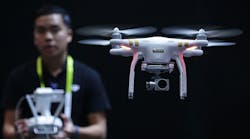SINGAPORE — Civilian drones are increasingly becoming a “real and growing threat” to the safety of commercial aviation, the International Air Transport Association warned Monday, calling for regulations to be put in place before any serious accidents occur.
IATA director-general Tony Tyler said the threat posed by unmanned aerial vehicles is still evolving as people are only starting to discover the many potential, non-military applications of the technology.
“I am as excited as you are about the prospect of having pizza delivered by a drone,” he said at an aviation conference in Singapore on the eve of the Singapore Airshow. “They are here to stay. But we cannot allow them to be a hindrance or safety threat to commercial aviation.
“We need a sensible approach to regulation and a pragmatic method of enforcement for those who disregard rules and regulations and put others in danger.”
As the use of drones expand from military to commercial and even recreational purposes, experts fear that these radio-controlled flying devices, if not regulated, could one day collide with a commercial aircraft with dire consequences.
“The issue is real,” Tyler said. “We have plenty of pilot reports of drones where they were not expected, particularly at low altitudes around airports. ... There is no denying that there is a real and growing threat to the safety of civilian aircraft.”
Rob Eagles, an IATA drones expert, said the industry group did not have figures on the number of drones in operation worldwide, but anecdotal evidence showed they were mushrooming.
When the Federal Aviation Administration ordered a registration of drones weighing up to 55 pounds last year, 300,000 were registered within just the first month in December, he said. While 55-pound drones are considered small, “this just gives you an indicator of the number of vehicles. … There’s going to be an increase in vehicles across the whole scope and range from small to medium size to the larger unmanned vehicles.”
'Close Encounters'
IATA’s primary concern is drones flying at low altitudes near airports, which could threaten planes that are taking off or landing, Eagles said.
Aviation regulators also want to make sure that the radio spectrum used to control the drones does not interfere with air traffic control systems, he said.
The Center for the Study of Drones at Bard College said in a report that it recorded 921 incidents involving drones and manned aircraft in U.S. airspace between December 2013 and September 2015. Among those, 36% were considered as “close encounters.”
“We found that over 90% of all incidents occurred above 400 feet, the maximum altitude at which drones are allowed to fly,” the center wrote in a report posted on its website. In 28 of the incidents, the commercial pilot had to maneuver to avoid collision.
Of the 191 states within the International Civil Aviation Organization (ICAO), 63 so far have regulations already in place for drones, Eagles said. Nine states have pending regulations, while five have banned their use.
“But there’s not a consistency across the regulations,” he said, adding IATA aims to help harmonize global rules. “There is an urgency associated with it because it’s such a fast-moving industry.”
By Martin Abbugao
Copyright Agence France-Presse, 2016



